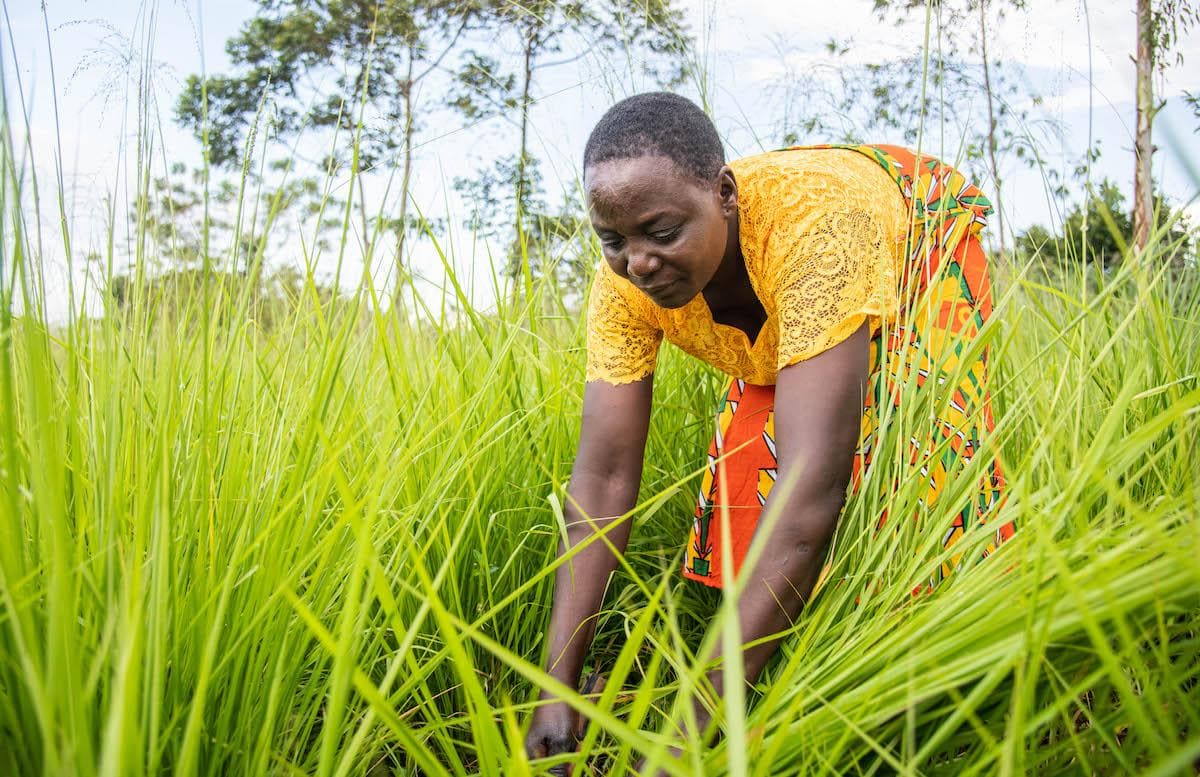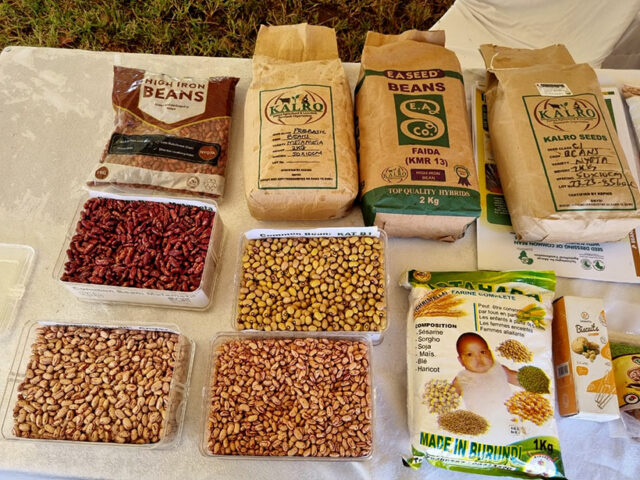
Every morning, Nelly Adhiambo wakes up just as dawn is breaking to feed her five cows and 30 chickens. Work on the farm starts early. She checks on her bananas, potatoes and maize which she grows on her plot to sell at the market for an income, and – in a surprising shift from what most farmers would consider growing on precious land – she checks her grass.“I used to go to the market to sell shoes,” explains Adhiambo. “But then I attended a training by the Kenya Agricultural Livestock and Research Organization (KALRO) and Send a Cow, and I realized I could earn more money from farming. I came to understand the importance of growing new grass varieties,” she says.Adhiambo describes how she started growing forages when she realized she could boost her milk yield with new Brachiara forage grass varieties. Where previously she would have yielded 15 liters of milk per day from her cows, which bring in 90% of her total farm income, now they yield 25 liters, boosting her monthly profit from US$270 to US$360 on average.Nelly Adhiambo has increased her milk production in Busia, Kenya. ©2020 Alliance/Georgina Smith“The increase has enabled me to earn better money than going to the market, to sustain the family of five children and my brother in law’s son as well as employ two workers,” she notes. “The grass improves animal health and the value of the milk is higher in terms of protein and fat content,” she says, adding that her cows have also put on weight.
Adhiambo is among 1,000 farmers reached by Send a Cow and The Alliance of Bioversity International and CIAT through the Grass to Cash project. Since 2018, researchers have been working together with communities in Busia, Kakamega, Bungoma and Siyaya counties, to bring new, protein-rich and climate-resilient grasses to farmers.
Alliance researcher Ruth Odhiambo explains: “Since 2018, we’ve been testing ten new varieties with farmers, including planting, site selection, weeding and feeding. So they see as much as we see and know everything we know about the new varieties, like how well this Mombasa variety is compared to others on this plot!” she says, pointing to a tall crop of lush green grass.
Researchers work with farmers to measure and weigh forage grasses in field trials to find better forage feed varieties together with KALRO, Send a Cow and Advantage Crops ©2020 Alliance/Georgina Smith“In Colombia, the Alliance holds the most diverse collection of tropical forage seeds in the world. The most interesting ones of these – like the ones with drought resilience or pest and disease resistance – are used in our breeding program where we combine resilient characteristics needed here in our local context in Kenya, to produce elite new grasses for any condition.”
“Most farmers rely on Napier which has protein content of around 8-10%, compared to these new Brachiara varieties which have double the protein content at around 16-18%,” she adds. The new varieties of forages help farmers improve their milk production while also boosting their income.
Researchers work with farmers to measure and weigh forage grasses in field trials to find better forage feed varieties together ©2020 Alliance/Georgina SmithFarmers and researcher teams are now harvesting the 11th set of field trial demonstrations, measuring stem-leaf ratio and other parameters. Traditional Napier produces almost triple the stem of new Brachiara varieties, meaning more bulk and less quality content for cows compared with new, leafier grasses. “Cows also love the new varieties,” notes Odhiambo.
KALRO forage agronomist David Miano explains that the new varieties have been rigorously tested locally before being released.
“The most interesting part of this project was that we talked about forages as a source of income. As we think of agriculture and making it a business, we need to convert what we are researching into a money making activity.”
Now, the Alliance, KALRO, Send a Cow and partners have joined forces with certified commercial seed company Advantage Crops, to commercialize seeds to reach more farmers. The seeds are packed into affordable sizes, from 50 gram to one kilogram packs varying in price between US$33 and US$36/kg depending on the forage variety.
Dennis Nyongesa and his wife have boosted their milk yield and income since using new grass varieties introduced by the Grass to Cash project ©2020 Alliance/Georgina SmithSurveying his plot in Busia, father of 11 Dennis Nyongesa concurs that the new varieties have made a big difference. Apart from doubling his milk yield from 10 liters a day per cow to 20 liters, bringing in on average US$3.65 extra income per person per day, he has also noted another advantage to growing new Brachiara varieties compared with Napier grass.As Chairman of the local cooperative, Nyongesa says: “The grass can be preserved in hay bales and transported to others or stocked. This is a good safety net, particularly in the dry season,” says Nyongesa. “We also store hay, so farmers can sell to those who don’t have grass nearby. Also youths can grow the grass and sell to other farmers.”Already, his cooperative has set up six demonstration plots. “Our income has improved so we can keep the work force and cover expenses like farm management or routine medication, sustaining the family’s daily needs and even education for the children,” he said, ensuring the benefits of the Grass to Cash project will extend well into the future. The Grass to Cash project is a project of the Alliance of Bioversity International and the International Centre for Tropical Agriculture (CIAT), in partnership with The Kenya Agriculture and Livestock Research Organization (KALRO), Advantage Crops Limited and Send a Cow and farmers.For more information, contact An Notenbaert: a.notenbaert@cgiar.org



